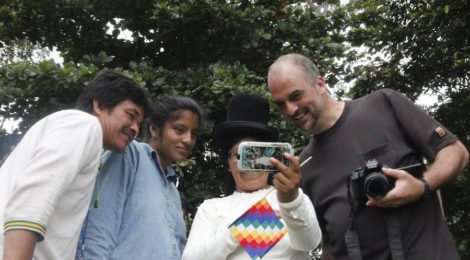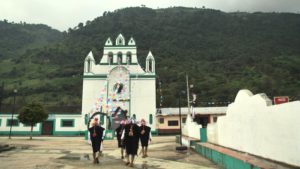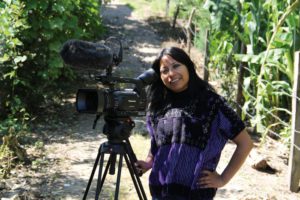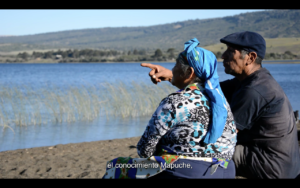
Dossier on Indigenous filmmaking from Abya Yala Part I: Tzotzil, Mapuche, Zapotec. Filmic Practice Otherwise.
In response to the recent interest in Indigenous languages on screen prompted by Roma (Cuarón, 2018) and Pájaros de verano (Gallego and Guerra, 2018), today, Mediático is delighted to present the first of a series of posts that will be published over the course of 2019, UN International Year of Indigenous Languages addressing Indigenous filmmaking and language’ by Claudia Arteaga* and Charlotte Gleghorn** on Indigenous filmmaking from Abya Yala (Latin America). This post begins with a short video, followed by an introductory text and then a description of two indigenous films and a film making programme; Bankilal (Maria Sojob 2014), Admongen, vida mapuche en Wallmapu (Advikum, 2017) and Campamento Audiovisual Itinerante.
En respuesta al reciente interés en las lenguas indígenas y el cine impulsado por Roma (Cuarón, 2018) y Pájaros de verano (Gallego y Guerra, 2018), hoy Mediático se complace en compartir la primera entrada de una serie de artículos y entrevistas realizadas por Claudia Arteaga* y Charlotte Gleghorn**, la cual se publicará a lo largo de 2019, Año Internacional de las Lenguas Indígenas. La serie, enfocada en el cine indígena de Abya Yala y su relación con el lenguaje, tanto estético como verbal, comienza con un video, acompañado de un breve texto que aborda las diferentes epistemologías vehiculadas en Bankilal (María Sojob 2014) Admongen, vida mapuche en Wallmapu (Adkimvn, 2017) y un programa de formacion el Campamento Audiovisual Itinerante.
Lea la versión en español aqui
Featured Image: Photo from the FestiLab training session in Chisec during FICMayab’. Courtesy of Red Tz’ikin
Tzotzil, Mapuche, Zapotec. Filmic Practice Otherwise.
by Claudia Arteaga and Charlotte Gleghorn
In 2018, two major feature films by Latin American filmmakers were released which have put the spotlight on cinema’s engagement with Indigenous languages. Alfonso Cuarón’s Roma, as Mediático’s December dossier reveals, has sparked heated debates about class conflict, voice, and Indigenous language in film, centred on the compelling performance of Yalitza Aparicio and her Mixtec dialogues with a fellow domestic worker.[1] Another film previously under consideration for Best Foreign Language Film in the 2019 Academy Awards, the long-awaited Pájaros de verano, directed by Cristina Gallego and Ciro Guerra, foregrounds not only the Wayuunaiki language but also modes of storytelling and Indigenous law, offering an original angle on the so-called Bonanza marimbera in Colombia. Wayúu crew and community members were actively involved in shaping the film’s narrative structure and production process, though it should be noted that of the lead cast, who all speak Wayuunaiki in the film, only one character, the palabrero, is Wayúu.
Both of these films are valuable contributions to discussions relating to Indigenous representation and the recent rise in productions from Latin America engaging with indigeneity. In fact, our conversations over the past months with friends, family, and colleagues have been characterised by the insistence of these two films. At this juncture, though, it seems important to call attention to the fact that these discussions are not new, nor are they the exclusive purview of celebrated, transnational Latin American filmmakers. In Abya Yala, Indigenous filmmakers have been theorising – through practice and criticism – the ways in which cinema nurtures Native prisms of knowledge-production for decades. By articulating their filmic practice in relation to specific epistemologies, they are resisting the way Indigenous narratives have been mishandled and distorted by others.
Drawing on our recent research at FICMayab’ in Guatemala – produced locally by Red Tz’ikin for the 13th International Indigenous Film and Media Festival convened by the umbrella organisation CLACPI – the accompanying video and its selection of interview excerpts, film clips and photographs shares a sample of the terms that are moulding anew cinema’s precepts and aesthetics. Below we describe the different sections of the video
Towards a Chu’lel cinema

Still from Bankilal (María Sojob, 2014). Courtesy of María Sojob
Film director, María Sojob (María Dolores Arías Martínez), conceptualizes an emerging Tzotzil approach to filmmaking. In Bankilal – Eldest Brother (2015), the resonance of incantation, of the intimate space of prayer, is palpable. The Bankilal – an authority entrusted with mediating with the spirits on behalf of his people – has a gift for words which infuses the process, pace, cut, and shot composition of the film. In Sojob’s film, oratory resignifies filmic practice and forges a chu’lel cinema.

María Sojob. Courtesy of Berlinale NATIVe/María Sojob
Adkimvn: The Image of Knowledge.

Screenshot: Admongen, vida mapuche en Wallmapu (2017). Courtesy of Adkimvn
Filmmaker-producer Gerardo Berrocal reflects upon the nature of the works produced by Adkimvn, the media collective of which he is part. In the documentary series Admongen – Mapuche Life in Wallmapu (2017) key community authorities – Lonko, Machi, Ngenpin and Werken – structure the different chapters of the series, the process of filming and editing, and reframe how Mapuche society is interpreted for a wider audience. Through immersion in the territory and its attendant principles of organisation, the winka [settler] audience is invited to understand Adkimvn, a Mapuche image of knowledge. This theorisation of Mapuche filmic practice chimes with that of Mapuche curator, Francisco Huichaqueo, who also recently shared his thoughts regarding Mapuche forms of curation in an article on curating the Indigenous image in Abya Yala.
Filmic comunalidad

Production shot from the Campamento Audiovisual Itinerante. Courtesy of the CAI
Luna Marán, Zapotec filmmaker and community media producer, theorises the work of the Itinerant Audiovisual Camp (CAI) in relation to the concept of comunalidad. Organised by the collective La Calenda Audiovisual, the CAI training programme pivots around pillars of Oaxacan Indigenous society: tequio, cargo, asamblea, fiesta. These values of community work, duty, assembly, and celebration permeate filmic practice and production, from inception to exhibition. Participants engage in an aesthetics of collective consensus, and the screening of CAI productions is conceived as a fiesta, a celebration of their labour and contribution.

Luna Marán
In these three examples, filmmaking is being redefined on Indigenous terms in diverse and specific ways, resulting in works that propose forms of Indigenous aesthetics that crystallise cultural, linguistic and spiritual values. The role of language is key to this endeavour, as is the significance of certain concepts, and this use of language and concepts is transforming the way in which Indigenous filmmaking is interpreted. In fact, by revealing interconnections between culture, language, context and production, as rooted in specific territories and cosmologies, the examples discussed here are challenging the very constitution of Indigenous cinema as a meaningful category to denote the vast range of audiovisual practices embraced under its banner. Finally, for critics of indigenous film there is an opportunity to valorise these epistemologies on their own terms, instead of always articulating them in opposition to Western systems.
* Claudia A. Arteaga is Assistant Professor in Spanish at Scripps College in Claremont, California. She specializes in indigenous film productions, representations of indigenous peoples in Latin American films, and communitarian modes of film production in Peru and Bolivia. She is the director of a short-documentary “Amahuaca. Construyendo territorio” (2018) about the Amahuaca people in the Peruvian rainforest. She made the film with the support of the Amahuaca people and the School of Amazonian Film (Escuela de Cine Amazónico). She is a member of SHARE Amazónica (Sociedad Histórico-Antropológica para respaldar la educación amazónica). Some of her publications are available here. Arteaga is currently preparing a book manuscript on the history and development of communitarian film in Peru.
Email: carteaga@scrippscollege.edu
** Charlotte Gleghorn is Lecturer in Latin American Film Studies at the University of Edinburgh. Her research engages with the political work of cinema, its relationship to processes of memory, women’s cinema, and Indigenous and Afro-descendant filmmaking. From 2009 to 2014, she worked on the European Research Council project ‘Indigeneity in the Contemporary World: Performance, Politics, Belonging’, hosted at Royal Holloway, University of London, during which time she also collaborated on the international exhibition of Indigenous art and performance ‘EcoCentrix: Indigenous Arts, Sustainable Acts’, at Bargehouse, Southbank, London. She has published her work in several anthologies on Latin American cinema, in Journal of Latin American Cultural Studies and Interventions, and has co-edited an Open Access volume of essays on Indigenous performance, Recasting Commodity and Spectacle in the Indigenous Americas (2014), available here. She is currently preparing a book manuscript as part of an AHRC Leadership fellowship on Indigenous filmmaking in Latin America.
Email: charlotte.gleghorn@ed.ac.uk
[1] The film also generated controversy regarding Netflix’s own subtitling practices and language normalization in relation to the release of the film in Spain. Cuarón termed the imposition of peninsular Spanish subtitles ‘parroquial, ignorante y ofensiva’. For more information on these discussions, see https://elpais.com/cultura/2019/01/08/actualidad/1546979782_501950.html






